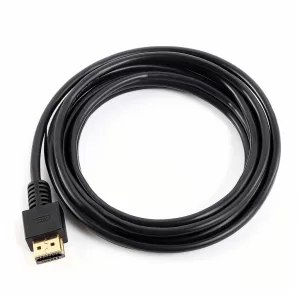
Step-by-Step RG6 Cable Installation for Beginners
April 26 2024 
Inquiry
Global electronic component supplier AMPHEO PTY LTD: Rich inventory for one-stop shopping. Inquire easily, and receive fast, customized solutions and quotes.
QUICK RFQ
ADD TO RFQ LIST
In this blog, we will equip you with the knowledge and skills to confidently tackle RG6 cable installation.
What is RG6 Cable?

What is RG6 Cable Used for?
RG6 cables provide the foundation of many home entertainment and data transfer systems. Here are some of their main applications:- Cable TV: RG6 wires are the industry standard for transmitting cable TV signals from the service provider to your home. They efficiently transfer video and audio signals, resulting in high-quality images and sounds.
- Satellite TV: Like cable TV, RG6 wires connect your satellite dish to the receiver, carrying the satellite signal for decoding and watching.
- High-Speed Internet (Cable and Satellite): Internet service providers (ISPs) commonly employ RG6 cables to supply cable or satellite internet connections. They effectively transport data signals, providing a dependable and speedy internet experience.
When was RG6 Cable Introduced?
The invention of RG cables dates back to the 1930s. With the development of cable television in the 1970s, RG6 became more widely used. Its capacity to handle greater frequencies than previous coaxial cable types made it ideal for relaying the complex signals required for cable television. Today, RG6 is a popular choice due to its versatility, low cost, and dependable performance.Can RG6 Cable Be Used for Internet?
Absolutely! As previously stated, RG6 cables are frequently utilized by ISPs to provide cable and satellite internet. Their ability to efficiently transport data signals qualifies them for high-speed internet connections.How does RG6 Cable Work?
The RG6 cable is a type of coaxial cable used for transmitting high-frequency communications. It relies on a few important components:- Central Conductor: This is the heart of the cable that transmits the signal. It is often made of copper or copper-clad steel.
- Dielectric Insulation: This insulation layer surrounds the center conductor and is commonly constructed of foam PE (polyethylene), keeping it insulated from the rest of the cable structure.
- Shielding: This consists of one or more layers of metallic foil and braided metal that help shield signals going through the core conductor from interference from external electromagnetic sources.
- Outer Jacket: The outer jacket provides physical protection and insulation to the cable.
- Signal Propagation: The signal travels through the core conductor. The coaxial cable's architecture ensures that the electromagnetic field carrying the signal is contained within the cable, between the central conductor and shield. This configuration reduces loss and eliminates interference from outside sources.
- Shielding against interference: The metallic shielding layers absorb and reflect external electromagnetic interference, keeping the transmission clear and uninterrupted across extended distances.
- Impedance Matching: Most RG6 cables have an impedance of 75 ohms, which corresponds to the impedance of the equipment they connect to, such as televisions and antennas. This impedance matching is critical to reducing signal reflection and loss.
Does Spectrum Use RG6 or RG11?
Spectrum typically uses RG6 cables for its cable TV and internet service installations. RG11 cable, with its thicker design and larger signal capacity, is commonly utilized for longer cable runs or applications that require more bandwidth, such as commercial installations.RG6 vs RG59
While RG6 and RG59 cables are both coaxial cables typically used in houses, there are some significant differences:- Size: RG6 cables are thicker and have a greater diameter than RG59 cables.
- Signal Capacity: RG6 cables can handle higher frequencies and broader bandwidths than RG59 cables. This results in improved signal quality and support for greater data speeds.
- Applications: RG6 cables are great for cable TV, satellite TV, and high-speed internet because of their enhanced signal handling capabilities. RG59 cables, while adequate for standard-definition video and low-speed data transfer, may not be ideal for high-definition material or demanding internet applications.
| Feature | RG6 | RG59 |
| Size (diameter) | Larger | Smaller |
| Signal Capacity | Higher | Lower |
| Applications | Cable TV, Satellite TV, High-Speed Internet | Standard-definition video, Low-speed data transmission |
How to Install RG6 Cable?
- Prepare the Cable:
- Measure the desired cable length. Remember that a slightly longer cable is usually preferable to a shorter one.
- Optional: If using a stripping tool, carefully remove a specified length of the outer jacket to reveal the inner braided shield.
- Optional: Use a cable cutter to make a clean, perpendicular cut at the cable end.
- Connector Preparation:
- Remove the nut and ferrule (metal ring) from the F-type connector.
- Slide the ferrule onto the cable, covering the exposed outer jacket.
- If using a stripping tool, gently remove a certain length of cable insulation per the crimping equipment's instructions. This exposes the internal copper conductor.
- Important: Don't nick or damage the inner conductor.
- Crimping the Connector:
- Place the prepared cable end (with exposed inner conductor and braid) in the middle of the F-type connection. The inner conductor should protrude slightly past the connector tip.
- Slide the ferrule back over the connection body and cable to ensure a snug fit.
- Place the connector and cable into the crimping tool, following the instrument's instructions. Most crimping tools feature slots for certain connectors and cable sizes.
- Crimp the connector tightly with the tool. Important: To avoid harming the connector or cable, follow the tool manufacturer's guidelines for optimum crimping pressure.
- Attaching the Connector to the Device:
- Screw the ferrule of the connector into the threaded port of your device (e.g., cable TV wall outlet, modem). Tighten it securely by hand, but don't overtighten it.
- Repeat steps 1-4 for the opposite end of the cable, making sure the connection type matches the device you're connecting to (for example, another F-type connector on a cable box).
- Testing the Connection:
- Turn on your gadgets (e.g., TV or modem).
- If you're using the cable for TV, make sure the picture and sound are clear.
- If you're using a cable for the internet, connect your computer or device and check for a successful connection.
Video related to How To Terminate RG6 Cable
Are RG6 and RG59 Interchangeable?
Due to their similar connector types, RG6 and RG59 cables may be physically interchangeable in certain non-critical applications. However, substituting RG59 for RG6 is generally not suggested. RG59's decreased signal capacity can cause signal deterioration, particularly over longer cable lengths, resulting in poor picture quality or slow internet connections. It is usually advisable to utilize the cable type advised for your particular application.Conclusion
By following these instructions and learning the fundamentals of RG6 cables, you'll be prepared to undertake cable installations with confidence. Remember, utilizing the right tools, following proper practices, and taking a systematic approach will ensure that your RG6 cables operate optimally for your home entertainment and internet requirements.Related Articles
- ·Stratix 10 VS Stratix V: Which FPGA is Right for Your Next Project?
- ·Intel Xeon Platinum 8454H vs AMD EPYC: Which Reigns Supreme?
- ·A Deep Dive into the AMD EPYC 4564P Processor
- ·MSP430F5438A vs MSP430F5529: A Detailed Analysis of Their Capabilities
- ·Comparing MSP430F6659 and MSP430F5419A: Which One is Right for Your Project?
- ·Exploring the Features of MSP430F5529 and MSP430F5638 Microcontrollers
- ·Demystifying 20 Microcontroller Projects for Beginners
- ·Unveiling the Ultimate Guide to Microcontroller Programming
- ·4680 Battery: Unveiling the Power Potential of the Next-Gen Cell
- ·Exploring the Case Studies on Arduino Applications
Populer Posts
